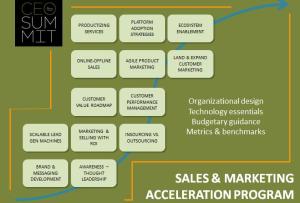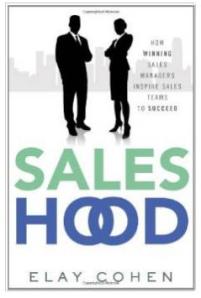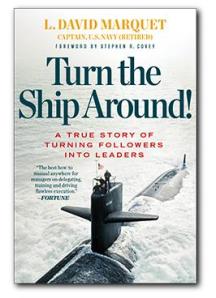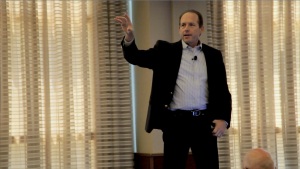Every CEO knows that sales and marketing KPIs and metrics are the veins through which information flows in a business. However, the gulf between knowing you need metrics and effectively implementing them can be massive. The devil is always in the details – how do we decide which metrics out of many to track? How do you define them and prioritize them? How should we establish targets and exactly who should be accountable? Our CEOs tackled these “rubber meets the road” issues at our recent CEO Summit. Leaders of our sausage-making roundtable, Sales & Marketing Metrics that Matter, included:
- Elay Cohen, CEO & co-founder of SalesHood and former SVP Sales at Salesforce.com
- Chris Terrill, CEO of Homeadvisor.com and board director of The Neat Company
- Rick Auletta, CEO of Softgate Systems
Managing the Metrics
Our CEOs recommend prioritizing your stable of metrics. Determine what the #1 metric is that moves the needle for your business, and then only those key ones that support that one metric. Make sure you don’t lose focus on it when you get down in the weeds of your day to day. Beyond that, each manager can only feasibly manage a limited number of metrics. Too many and their attention gets divided too thinly and they aren’t effective.
A simple construct which seems to work is the 3×3 structure. Identify the three key metrics in three key functional or strategic areas for a leader to focus on, then move on to managers and their metrics at the level below, and rinse, wash, repeat through the organization. Metrics also need to be as transparent as possible. Everyone in the organization should understand how each key metric is calculated and what the main levers are to move the needle. These measures should be public and linked to performance. A good metric enables you to reward your all-stars and do so in a fashion that highly visible to the rest of the organization.
Sales Metrics
One point that resonated with the group was that any measurement of sales effectiveness needs to start with activity. Activity translates into productivity and ultimately revenue – so activity metrics are the best leading indicators of sales performance. Metrics like numbers of calls, connects, and meetings give management visibility into whether or not a rep, territory, or even product line can be successful. The key here is transparency, openness, and taking a holistic view. No metric has been established that hasn’t been gamed, so ensuring that achieving the metric also supports the broader goals of a business is critical.
Another critical, but often overlooked, topic is how to align the marketing function with sales to help achieve overall revenue goals. Our group found there is often not enough pressure or accountability allocated to the marketing function. Marketing needs to not only have a set of metrics they are accountable to, but those metrics must be layered to synchronize with sales and support the overall goal of revenue generation. There needs to be a true partnership driven between marketing and sales – their goals should be architected in such a way that they experience linked success and failure.
Taking A Second Look
The process of instrumenting a sales and marketing organization isn’t a one-time deal. The metrics that managers have selected need to be re-evaluated on a periodic basis. Our CEOs believed metrics were “in their DNA,” but until they actively reviewed the metric system they had instituted, they didn’t realize how much they still had to learn. Often, the people measuring the metrics end up further and further from the front lines over time, and data can become muddied or incomplete. Measurement should happen as close to the actual event as possible, and ensuring the right people are measuring the right things is an ongoing process in a business. New metrics need to be introduced into a business over time, and old ones discarded as products, markets, and organizations change. Many of our CEOs discovered new insights about their business after bringing in a new set of standard metrics – it provided them the right lens to reveal the strengths and weaknesses formerly obscured by incomplete measurements.


























